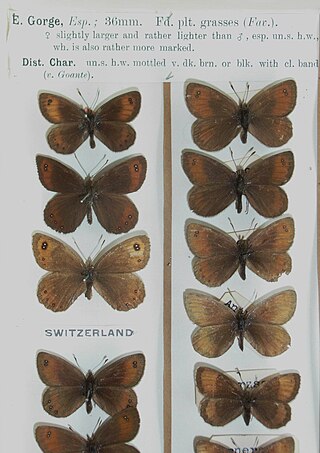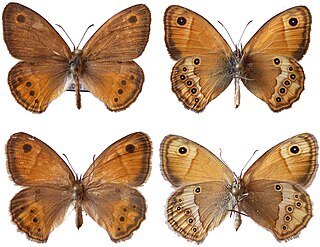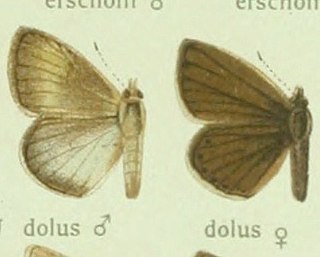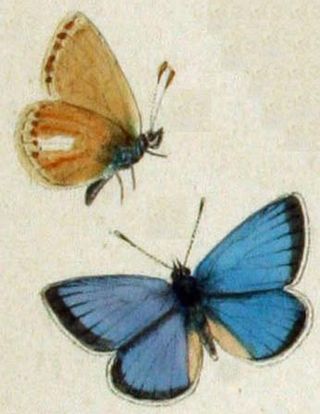
The chalkhill blue is a butterfly in the family Lycaenidae. It is a small butterfly that can be found throughout the Palearctic realm, where it occurs primarily in grasslands rich in chalk. Males have a pale blue colour, while females are brown. Both have chequered fringes around their wings.

The Adonis blue is a butterfly in the family Lycaenidae. It inhabits the Palearctic realm.

Cyaniris semiargus, the Mazarine blue, is a Palearctic butterfly in the family Lycaenidae.

The purple-shot copper is a butterfly in the family of the Lycaenidae or copper butterflies and in the genus of the Lycaena.

Polyommatus eros, the Eros blue or common meadow blue, is a species of blue butterfly found in the Palearctic.

Lasiommata maera, the large wall brown, is a butterfly in the family Nymphalidae.

The silky ringlet is a member of the subfamily Satyrinae of the family Nymphalidae. It is a high-altitude butterfly found on screes in the Alps, Pyrenees, central Italy and the Balkans. It is a very variable butterfly.

The black ringlet is a member of the subfamily Satyrinae of the family Nymphalidae. It is a high-altitude butterfly found in Albania, former Yugoslavia, Bulgaria, Greece, and Romania.

Glaucopsyche alexis, the green-underside blue, is a butterfly of the family Lycaenidae. It is found in the Palearctic.

Polyommatus amandus, the Amanda's blue, is a butterfly of the family Lycaenidae. It is found in the Palearctic realm.

Polyommatus damon, the Damon blue, is a butterfly of the family Lycaenidae.

Polyommatus daphnis, the Meleager's blue, is a butterfly of the family Lycaenidae.

Coenonympha dorus, the dusky heath, is a butterfly of the family Nymphalidae. It is found in south-western Europe and North Africa.

Polyommatus dolus, the furry blue, is a butterfly of the family Lycaenidae. It is found in Spain, in France and Italy.

Polyommatus (Plebicula) dorylas, the turquoise blue, is a butterfly of the family Lycaenidae. It is found in southern Europe, Asia Minor, the Ural Mountains, Caucasus and Transcaucasia. Its wingspan is 15–17 mm. The butterfly's common name comes from the dazzling bright blue colour of male's wings. The larvae feed on Anthyllis vulneraria. The butterfly flies from May to September in two generations. Habitats include flowery meadows in rocky areas at 500–2000 m.

Polyommatus stoliczkanus is a butterfly in the family Lycaenidae. It is found from the western Himalayas to Nepal.

Polyommatus admetus, the anomalous blue, is a butterfly of the family Lycaenidae. It was described by Eugenius Johann Christoph Esper in 1783. It is found in south-eastern Europe and Turkey.

Aricia anteros, the blue argus, is a European butterfly in the family Lycaenidae. It has a wingspan of 30–34 mm. In Europe it can be found in Macedonia, Albania, Greece, Bulgaria, Serbia, Croatia, Montenegro, Bosnia and Herzegovina, Romania, Ukraine and in Turkey. Its primary larval food plants are Geranium sanguineum and Geranium macrorrhizum.

Polyommatus damone is a Palearctic butterfly in the Lycaenidae family.

Polyommatus magnifica is a butterfly in the family Lycaenidae. It was described by Grigory Grum-Grshimailo in 1885. It is found in Ghissar, Alai, and W.Tian-Shan





















